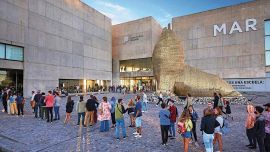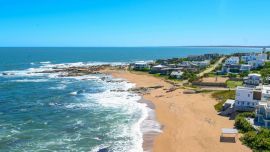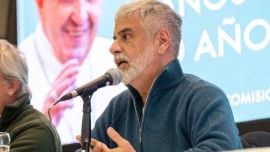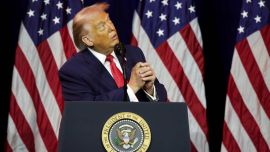Alberto Fujimori, the former president of Peru who oversaw the defeat of Maoist terrorists, tamed hyperinflation and continued to loom large over national politics after being imprisoned for his role in killings by death squads, has died. He was 86.
His family announced his death, from cancer, on Wednesday.
Fujimori served 19 years in prison before being temporarily released in 2017 and permanently in December 2023 by a court ruling that upheld a presidential pardon. Once free, and despite facing health issues, Fujimori had ushered himself back into political life, flirting recently with the idea of running for president once again in the upcoming 2026 elections.
“We’ll see,” Fujimori said of his potential candidacy on Sept. 5.
During his imprisonment, his family maintained its role as the nation’s most powerful political dynasty. His daughter, Keiko Fujimori, narrowly lost the presidency three times since 2011 and heads the Popular Force party, which has outsized influence in Congress. Fujimori joined Popular Force following his prison release.
A former mathematics professor and son of Japanese immigrants, Fujimori came from outside Peru’s political establishment to win the presidency in 1990 and radically alter the nation’s path. He defeated Mario Vargas Llosa, the famed Peruvian writer who would go on to win a Nobel Prize in Literature. In his 10 years in power, he presided over the revival of a shattered economy and the defeat of the Shining Path, one of the world’s most bloodthirsty guerrilla movements.
But Fujimori’s legacy was tainted by his authoritarian decision to shut down Congress and the judiciary in 1992, temporarily ruling by decree. His administration crumbled in 2000 over videos showing his top aide bribing scores of officials with cash.
“He inherited a catastrophe,” said Anthony Quainton, who was US ambassador to Peru from 1989 to 1992. “The economy was in total collapse and bombs were going off every day. He changed the course of Peru, and the country has been on that track ever since.”
Economic shock
In his 1990 showdown with Fujimori, Vargas Llosa campaigned with a right-wing platform promising radical cuts to tame hyperinflation, saying an economic shock was needed. Fujimori opposed the idea. Within weeks of taking office, however, he eliminated subsidies and lifted controls on prices, currency and interest rates, in what became known as the "Fujishock."
“May God help us,” his finance minister said in announcing the cuts.
The move worked. Peru’s annual inflation cooled from over 7,000 percent the year he took office to four percent by the time he left. Fujimori also sold off hundreds of state-owned companies, including phone provider Compañía Peruana de Teléfonos.
Argentine President Javier Milei’s recent efforts at stabilising inflation in his country have drawn comparisons to Fujimori’s drastic measures.
An admirer of the fast-growing East Asian economies, Fujimori sought to repeat the success of Malaysian Prime Minister Mahathir Mohamad, who oversaw strong growth in the 1990s, said Roberto Abusada, a former chief adviser to the Finance Ministry during Fujimori’s first term.
Authoritarian tendencies
His authoritarian tendencies became apparent in 1992, when he used troops to close Congress and suspended the constitution while increasing the power of the armed forces. Military officials vetted newspaper and television coverage of Fujimori’s so-called "self-coup," blocking images of tanks on the streets of central Lima and of opposition lawmakers being detained.
Security forces captured Shining Path leader Abimael Guzmán in September 1992, bringing an end to the movement’s war against the state. Guzmán died in jail in 2021.
Fujimori’s approval rating surged to a record 81 percent after he shut Congress from 53 percent a month earlier, according to Lima-based researcher Ipsos Apoyo. He called congressional elections in November 1992, and legislators approved a new constitution the following year.
But Fujimori came to rely on the national intelligence service to assert influence over his political opponents, the military, and the media.
As foreign investment returned to Peru, the economy rebounded. Though more than half the country lived in poverty, the victories over the guerrillas and hyperinflation, and the debilitated opposition, secured Fujimori’s re-election in 1995.
Hostage crisis
He cemented his strongman image and shored up his flagging popularity in 1997 with his handling of a hostage crisis after guerrillas from the Túpac Amaru Revolutionary Movement stormed the Japanese ambassador’s residence in Lima. He ended the siege by sending in a commando force that freed the hostages and killed the 14 insurgents.
Fujimori ran for a third term in 2000 despite a constitutional two-term limit on presidents, and he was declared the winner of elections the Organisation of American States said were rigged. In September of that year, intelligence chief Vladimiro Montesinos was caught on videotape bribing opposition lawmakers.
Two months later, Fujimori fled to Japan and tendered his resignation, which Congress rejected, opting instead to remove him from office by impeachment on grounds “moral incapacity.”
Montesinos was jailed and sentenced and would go on to become neighbours in prison with Guzmán.
Master’s in mathematics
Alberto Kenya Fujimori was born on July 28, 1938, in Lima. He earned a degree in agronomy from the Universidad Nacional Agraria La Molina.
He went on to study physics at the University of Strasbourg in France and received a master’s degree in mathematics from the University of Wisconsin at Milwaukee. He returned to his alma mater in Lima as a mathematics professor and became dean in 1984.
In 1990 he made a dual bid for the Senate and the Presidency. Though a Senate seat was believed to be his main ambition, his presidential campaign took off in the shantytowns of Lima and other major cities. He won a run-off vote against Vargas Llosa, who led a coalition of established political parties.
“He presented himself as just another poor Peruvian, disgusted with the political class that had never resolved the country’s problems,” Vargas Llosa wrote in an account of the election in his 1993 memoir A Fish in the Water.
Fujimori’s ties to Japan appealed to Peruvians who saw the Asian country as honest, hardworking and high-tech — everything Peru wasn’t, Quainton said.
Safe harbour
After his hasty exit from Peru in 2000, Japan recognised Fujimori as a Japanese citizen. That saved him from being extradited back to the country he once led to face charges of directing a paramilitary death squad.
In 2005, however, he was arrested in Chile while laying groundwork for a planned presidential bid in Peru’s elections the following year. He was extradited to Peru and put on trial two years later for his involvement in two massacres of 25 people and the kidnappings of a journalist and a businessman, charges he denied.
He was sentenced to 25 years in prison in April 2009. He was twice released — on Christmas Eve 2017 following a presidential pardon that was overruled by a court, and then in 2023 when a court restated the pardon. Fujimori’s release also defied an international court that had barred the move.
He was also accused of responsibility for the forced sterilisation of thousands of impoverished indigenous women, which happened as part of a birth control programme organised by his government.
Special prison
Fujimori served his sentence at a specially built prison within a police barracks on the outskirts of Lima. He was initially its only inmate but eventually shared the facility with three disgraced former leaders at different points in time. Fujimori was hospitalised several times to treat cancerous lesions on his tongue.
He had four children with his former wife, Susana Higuchi, from whom he was divorced in the mid-1990s. They include Keiko Fujimori, who has also been plagued by scandals and spent time in jail. She ran for president in 2011, 2016 and 2021, trying to rescue her father’s legacy. She lost all three elections in the second-round runoff.
She narrowly lost the 2021 election to Pedro Castillo, a rural school teacher from a Marxist party, opposed to most of what her father stood for. Castillo was jailed in 2022 after trying to shut down Congress and the Judiciary — a failed move that drew comparisons to Fujimori’s very popular 1992 self-coup.
Castillo was imprisoned in the same jail as Fujimori, where he remains behind bars.
related news
by John Quigley & Marcelo Rochabrun, Bloomberg

























Comments